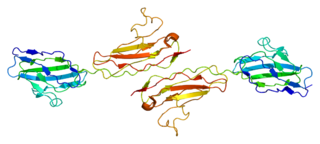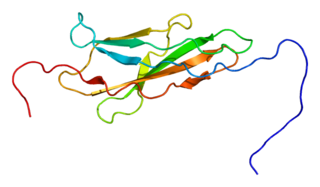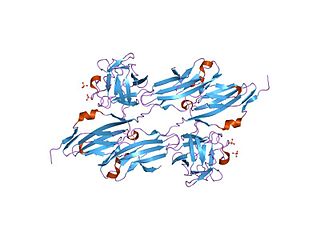Contactin-2 is a protein that in humans is encoded by the CNTN2 gene. [5] [6] [7]
Contactin-2 is a protein that in humans is encoded by the CNTN2 gene. [5] [6] [7]
The protein encoded by this gene is a member of the immunoglobulin superfamily. It is a glycosylphosphatidylinositol (GPI)-anchored neuronal membrane protein that functions as a cell adhesion molecule. It may play a role in the formation of axon connections in the developing nervous system. It may also be involved in glial tumorigenesis and may provide a potential target for therapeutic intervention. [7]
CNTN2 has been shown to interact with CNTNAP2 [8] and NFYB. [9]
The L1 family is a family of cell adhesion molecules that includes four different L1-like proteins. They are members of the immunoglobulin superfamily. The members of the L1-family in humans are called L1 or L1cam, CHL1, Neurofascin and NRCAM. L1 family members are found on neurons, especially on their axons. Sometimes they are found on glia, such as Schwann cells, radial glia and Bergmann glia cells and, as such, are important for neural cell migration during development. L1 family members are expressed throughout the vertebrate and invertebrate kingdoms.

L1, also known as L1CAM, is a transmembrane protein member of the L1 protein family, encoded by the L1CAM gene. This protein, of 200-220 kDa, is a neuronal cell adhesion molecule with a strong implication in cell migration, adhesion, neurite outgrowth, myelination and neuronal differentiation. It also plays a key role in treatment-resistant cancers due to its function. It was first identified in 1984 by M. Schachner who found the protein in post-mitotic mice neurons.

DSCAM and Dscam are both abbreviations for Down syndrome cell adhesion molecule. In humans, DSCAM refers to a gene that encodes one of several protein isoforms.

Myelin protein zero is a single membrane glycoprotein which in humans is encoded by the MPZ gene. P0 is a major structural component of the myelin sheath in the peripheral nervous system (PNS). Myelin protein zero is expressed by Schwann cells and accounts for over 50% of all proteins in the peripheral nervous system, making it the most common protein expressed in the PNS. Mutations in myelin protein zero can cause myelin deficiency and are associated with neuropathies like Charcot–Marie–Tooth disease and Dejerine–Sottas disease.

Intercellular adhesion molecule 2 (ICAM2), also known as CD102, is a human gene, and the protein resulting from it.

Nuclear transcription factor Y subunit beta is a protein that in humans is encoded by the NFYB gene.

Carcinoembryonic antigen-related cell adhesion molecule 1 (CEACAM1) also known as CD66a, is a human glycoprotein, and a member of the carcinoembryonic antigen (CEA) gene family.

Junctional adhesion molecule A is a protein that in humans is encoded by the F11R gene. It has also been designated as CD321.

Contactin 1, also known as CNTN1, is a protein which in humans is encoded by the CNTN1 gene.

Neurofascin is a protein that in humans is encoded by the NFASC gene.

Neuronal cell adhesion molecule is a protein that in humans is encoded by the NRCAM gene.

CMP-N-acetylneuraminate-poly-alpha-2,8-sialyltransferase is an enzyme that in humans is encoded by the ST8SIA4 gene.

Contactin-4 is a protein that in humans is encoded by the CNTN4 gene.

Poliovirus receptor-related 3 (PVRL3), also known as nectin-3 and CD113, is a human protein of the immunoglobulin superfamily which forms part of adherens junctions.

Contactin-3 is a protein that in humans is encoded by the CNTN3 gene.

Protein sidekick-2 is a protein that in humans is encoded by the SDK2 gene.

I-set domains are found in several cell adhesion molecules, including vascular (VCAM), intercellular (ICAM), neural (NCAM) and mucosal addressin (MADCAM) cell adhesion molecules, as well as junction adhesion molecules (JAM). I-set domains are also present in several other diverse protein families, including several tyrosine-protein kinase receptors, the hemolymph protein hemolin, the muscle proteins titin, telokin, and twitchin, the neuronal adhesion molecule axonin-1, and the signalling molecule semaphorin 4D that is involved in axonal guidance, immune function and angiogenesis.

Contactin 6 is a protein in humans that is encoded by the CNTN6 gene.

Transmembrane and immunoglobulin domain containing 2 is a protein that in humans is encoded by the TMIGD2 gene. TMIGD2 was discovered by Nader Rahimi.

Sidekick cell adhesion molecule 1 is a protein that in humans is encoded by the SDK1 gene.